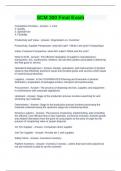SCM 300 Final Exam
Competitive Priorities - Answer- 1. Cost
2. Quality
3. Speed/Time
4. Flexibility
Productivity and Value - Answer- Organization vs. Customer
Productivity: Supplier Perspective- what did I get? / What is the price? Output/input
Value: Customer Perspective- what did I make? /What was the cost?
What is SCM - Answer- The efficient integration of supplier's manufacturers,
transporters, DC, warehouses, retailers, and all other parties associated in delivering
the final good or service.
Operations Management - Answer- Design, operations, and improvement of product
systems that efficiently transform inputs into finished goods and services which leads
to maximizing productivity.
Logistics - Answer- Is the COORDINATED Planning and Execution of product
distribution, preparation of packaged product, transport and warehousing.
Procurement - Answer- The process of obtaining services, supplies, and equipment
in conformance with corporate regulations.
Upstream - Answer- Stage of the production process involves searching for and
extracting raw materials.
Downstream - Answer- Stage in the production process involves processing the
materials collected during the upstream stage into a finished product
Reverse Logistics - Answer- The process of planning, implementing, and controlling
the efficient, cost effective flow of raw materials, in-process inventory, finished goods
and related information from the point of consumption to the point of origin for the
purpose of recapturing value or proper disposal.
1st Tier Supplier - Answer- Companies direct supplier
2nd Tier Supplier - Answer- Provide tier 1 with supplies
Safety Stock - Answer- Insurance inventory
Pipeline Inventory - Answer- Inventory in transit; , orders that have been placed but
not yet received or paid for by the customer
,Vertical Integration - Answer- A company taking on additional supply chain
responsibilities that used to be done by outside parties
Benefits of High Inventory Levels - Answer- >>Higher levels of customer service
>>Quantity discounts
>>Fewer orders placed
>>Greater security for demand variability
(Cons for Low): BUYING the Inventory - Cost to purchase (consider quantity
discounts) •STOCKING OUT - Poor customer service levels, PAYING the
Purchasing People- Costs to order inventory, TRANSPORTATION: Ease, Cost
Benefits of Low Inventory Levels - Answer- >>Less storage space
>>Lower change of obsolesence
>>Less materials handling requirments
>>More money available for investment opportunities
(Pros for Low): Cost of holding Inventory, Materials handling - Cost to handle
inventory, loss of Inventory - Shrinkage/Obsolescence, ties up your cash - Capital
investment options
What is the EOQ? - Answer- Economic Order Quantity, the optimal order size, using
it you will get the lowest total cost for the given cost structure and demand forecast.
When annual holding costs=annual ordering costs you get the EOQ.
What does it mean if AHC > AOC? Increase or decrease Q? - Answer- You would
lower quantity, because it is above the EOQ.
What does it mean if AHC < AOC? Increase or decrease Q? - Answer- You should
increase quantity, because it below the EOQ.
What should be considered in choosing a supplier? - Answer- >>Cost
>>Quality
>>Location
>>Innovation
>>Flexibility
>>Speed ect..
Cost, Quality, location, innovation, flexibility, speed, core competencies, time,
reliability, commitment to improvement, etc.
Line Flow - Answer- Demand: Standard Items, High Volumes, Static Industry.
Layout: Product Focused/Line Flow Layouts.
Manufacturing system: Assembly Lines, Continuous Flow Systems.
Make-to-stock systems.
, Key points: Low per unit Cost(long-term), Consistent Quality, Fast Production Rates,
Minimal Customization Opportunities, Product Lines very consistent, Make-to-Stock,
Start -up costs may be very high
Flexible Flow - Answer- Demand: Customized Items, Low Volumes, Dynamic
Industry. Layout: Process Focused/Flexible Flow Layouts.
Manufacturing system: Job Shops.
Make-to-order system.
Key points: High per unit cost, High performance and design, Slow production rates,
Customization opportunities likely, difference between products may be great, Make-
to-order, Start-up costs relatively low.
Hybrid Systems - Answer- Demand: Moderation (Customization, Changes, Industry).
Layout: Hybrid Layouts.
Manufacturing system: Group Technology (Cellular) Layout.
Possibly an Assemble-to-order system.
Key points: Assemble-to-order, Start-up costs are moderate, Labor, machines, tools=
mix, Lead times dictated by both processing rates and delivery, Changeovers=
depends, Inventory= depends.
Cycle Time - Answer- Maximum time allowed for work on one unit at each station.
This dictates the total time it takes for one unit to come off assembly line. CT helps
us determine our max capacity.
Bottleneck - Answer- One station taking more time required than the rest of the
stations and creating a back up in unfinished goods. If you have too many
bottlenecks or even just one bottleneck it increases your total task time, and thus
diminishing your max capacity. (You're only as strong as your weakest link)
Established Channels of Distribution - Answer- Represent the chain of organizations
that help bring a product into the hands of the end user.
Established Supplier Base - Answer- Implies than an organization has a group of
companies with which they have developed a working relationship
Describe: Major Cargo Classifications. Examples - Answer- Bulk: which is free
flowing cargo stored loose and is usually loaded by shovel. (EX: coal, rice)- usually
pumped, scooped, shoveled, etc.)
Break Bulk: which is general or packaged cargo often containerized, Cargo that is
packaged and/or secured on a pallet.
Neo-Bulk: typically, large items that don't quite fit into either the bulk or break bulk
categories. (Ex. Vehicles, logs, and livestock)




